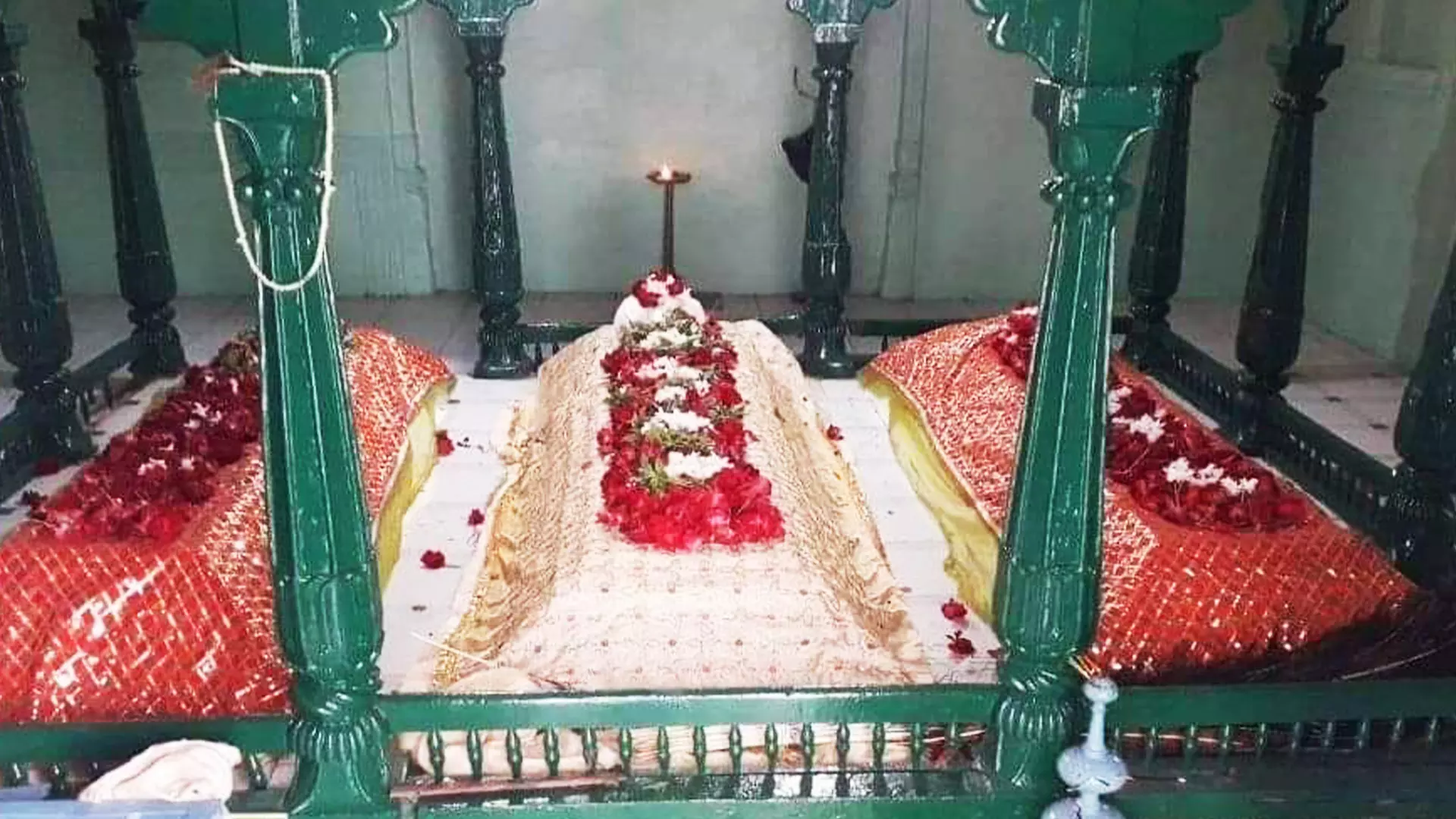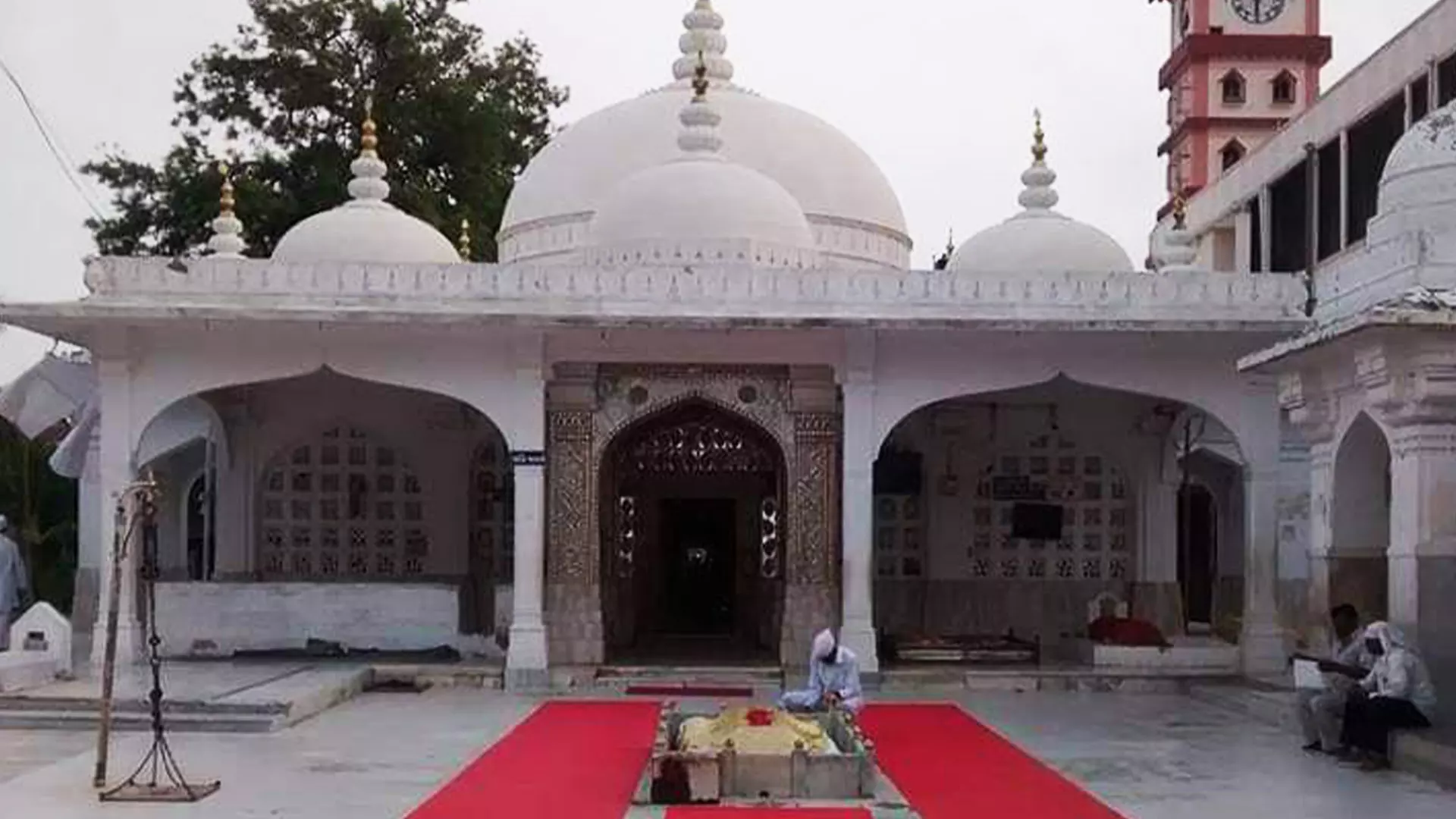
- Home
- India
- World
- Premium
- THE FEDERAL SPECIAL
- Analysis
- States
- Perspective
- Videos
- Sports
- Education
- Entertainment
- Elections
- Features
- Health
- Business
- Series
- In memoriam: Sheikh Mujibur Rahman
- Bishnoi's Men
- NEET TANGLE
- Economy Series
- Earth Day
- Kashmir’s Frozen Turbulence
- India@75
- The legend of Ramjanmabhoomi
- Liberalisation@30
- How to tame a dragon
- Celebrating biodiversity
- Farm Matters
- 50 days of solitude
- Bringing Migrants Home
- Budget 2020
- Jharkhand Votes
- The Federal Investigates
- The Federal Impact
- Vanishing Sand
- Gandhi @ 150
- Andhra Today
- Field report
- Operation Gulmarg
- Pandemic @1 Mn in India
- The Federal Year-End
- The Zero Year
- Science
- Brand studio
- Newsletter
- Elections 2024
- Events
How Hindu-Muslim unity was buried under a 400-year-old Sufi shrine in Ahmedabad

In February 2002, when communal riots rocked Gujarat and left a trail of violence and destruction in Ahmedabad, a small locality on the outskirts of the city, Pirana, remained untouched by the communal tension. Pirana village, 18 kilometres from Ahmedabad city has grown around a 550-year-old Sufi shrine over the years, a thread that held the villagers and the peace between them together.For...
In February 2002, when communal riots rocked Gujarat and left a trail of violence and destruction in Ahmedabad, a small locality on the outskirts of the city, Pirana, remained untouched by the communal tension. Pirana village, 18 kilometres from Ahmedabad city has grown around a 550-year-old Sufi shrine over the years, a thread that held the villagers and the peace between them together.
For more than 550 years, the shrine that has stood around the grave of Sufi saint Hazrat Imamshah Bava and his family, has been revered by both Muslims and Hindus of Pirana.
However, the centuries-old-grave of the Sufi saint was razed to ground on May 8 this year. What was razed along with the grave were 550-year-old history and a symbol of religious unity.

File photo of the grave of Sufi saint Hazrat Imamshah Bava.
As per the FIR filed by the Ahmedabad rural police, the attack to flatten the graves of Imamshah and his family members was led by a Hindu mob in the wee hours of May 8. Muslims living in Pirana village reached the spot as soon as they came to know about the incident.
The confrontation led to heated argument, and stones were pelted from both communities injuring four people including a police inspector.
Later, the Ahmedabad rural police detained 30 people who were released the next day.
“The Imamshah Baba Roza trust has members from Hindu and Muslim communities and there has been a long-standing dispute over the shrine. During the wee hours on May 8, people from both communities gathered at the shrine after they learned about the graves being razed. Stone pelting and clashes grew intense as the cops reached the spot,” said Omprakash Jat, superintendent of police, Ahmedabad rural.
A team of LCB (Local Crime Branch) and SOG (Special Operations Group) of Ahmedabad rural police had to be called to control the situation and patrol the area over the next few days.
“We objected to the razing of the graves and demanded restoration. The police officers assured us they will ask the trustees to rebuild the graves. They have been promised that every time attempts are made to turn this shrine into a temple but there has been no action yet,” said Azhar Saiyed, a descendant of the saint and a resident of Pirana.
Noticeably, a small temple-like structure was erected at the site of the grave following the communal tension and a diya (oil lamp) was lighted at the spot.
“We don’t know who built the structure yet. We are still investigating the matter,” said Jat.
The 16th century shrine – symbol of religious unity
The Sufi shrine, or dargah, of Saint Imamshah Bawa dates back to 600 years and has been always revered the residents of Pirana and nearby areas cutting across religious divides.
The Hindu devotees of the Saint are called Sathpanthis while the Muslim followers are called Shahdads or Saiyeds.

The Sufi shrine, or dargah, of Saint Imamshah Bawa dates back to 600 years and has been always revered the residents of Pirana and nearby areas cutting across religious divides.
A trust has been taking care of the dargah of Pir Imamshah Bawa, a mosque, a tomb of the pir and a graveyard, on the premises. Currently, there are 11 members — including eight Hindus and three Muslims — in the trust that has been the custodian of the shrine.
Imamshah Bava had influenced the Patels, the Shekhdas and other Hindu agrarian communities of the 16th century. Legend has it that the pir brought rain to the starving farmers of Pirana area, which was facing drought since two years after which the saint gained followers from all religions. The shrine has been a confluence of Hindiusm and Islamic culture ever since.
“The flag on the dargah is green in colour as per the Islamist culture but the flag is white at Imamshah Bava’s grave which is a culture of Hindu faction of the Satpanthis,” says Gautam Sah, an Ahmedabad-based sociologist.
“Out of the 10 trustees of the Pir Imamshah Bava Roza Sanstha Committee trust, which is the administrative body of Imamshah Bava's dargah complex, seven are Kutchi Patels and three are Saiyeds, who are believed to be direct descendants of the saint. The chairman of the trust is also from Kutchi Kadva Patel community, who is known as kaka among both the religious groups,” added Shah.
History of violence and attempts to build a temple
The feud around the dargah dates back to 1992 when the shrine featured in the list of “religious institutions to be claimed back” by the Gujarat Vishva Hindu Parishad (VHP) led by Babu Bajrangi, accused in multiple cases of 2002 riots.
“It was just after the demolition of the Bari Masjid in Ayodhya. In Gujarat, like many parts of the country, Hindutva extremists chanted slogans like Ayodhya toh jhanki hai, Kashi-Mathura baki hai (Ayodhya is just a trailor. Kashi and Mathura remain to be conquered) around the Pirana area with an aim to reclaim places of worship of the minority community or places like the dargah that were a confluence of religions,” said Sophia Khan, an advocate and a human rights activist based in Ahmedabad.
“Due to the continuous intervention of the VHP members and their influence on the Hindu trustees, a feud began between the Satpanthis and Saiyyed trustees. But situation had still not turned communal. The feud primarily revolved around the identity of the saint and was confined to the trustees only. The dargah continued to witnessed worshipers from across faiths. Even during the riots of 2002, Pirana remained unaffected due to the culture of religious amity around the dargah,” adds Khan.
The genesis
The shrine witnessed the first communal flare up in 2011. It all started after the VHP planned to hold a three-day a conclave of volunteers working to spread religion starting November 5, 2011, a day before Bakr Eid. The VHP leadership of Gujarat planned that those attending the event - Dharm Prasar Akhil Bharatiya Karyakarta Sammelan, were to stay on the premises of the dargah.
The media reports of the events sent the Muslim trustees of the shrine into a tizzy and they wrote a letter to the then Governor of Gujarat Kamla Beniwal.
“This is an unnecessary and provocative attempt to provoke communal tension within the state of Gujarat, a concern that has been expressed by both local residents and the religious head of the Pirana dargah. It appears as not a coincidence that the timing of the VHP’s three-day convention after years of silence comes at a time that coincides with Bakri Eid, a day that will see considerable crowd of Muslims at the dargah,” the letter read.
However, the event was held under the leadership of Babu Bajrangi. Despite police presence there were clashes and arrests were made.

Current photo of the location of the grave that was razed. A temple like structure has been built and a diya has been placed inside it.
In 2021, the shrine was in the news again concerning a feud over the shrine’s identity between its Hindu and Muslim followers.
The Hindu trustees of the shrine began calling the Sufi saint as Sadguru Hanstej Maharaj, sparking reaction from the Muslim followers. Following this, Sirajjuddin Saiyed, representing the Muslim trustees of the shrine, filed a PIL in the Gujarat High Court against the renaming of the saint. He, however, withdrew the petition within months after an agreement was reached amongst the trustees on not changing the religious identity of the dargah.
In 2022, the dargah witnessed communal tension after a wall was constructed on the premises of the Sufi shrine complex.
Hundreds of residents of Pirana village protested on January 30, 2022, against the wall that had replaced a wire fence inside the dargah separating the graves with the rest of the area. A group of Muslim followers even sat on hunger strike following the incident.
The Aslali police in Ahmedabad, within whose jurisdiction the area falls, had detained 133 protesters, including 64 women.
“This wall construction was viewed by the Muslim community as an act of aggression. While some resorted to protests, many families migrated out of the village out of fear for their safety and apprehending further violence,” said Azhar Saiyyed, a resident of Pirana who sat on a protest against the wall back then.
In August 2023, the Pirana area was once again communally tensed after a tilak was put on a 15th century painting of the Saint Imamshah Bawa.
“A tilak was put on a 15th century painting of the Saint Imamshah Bawa to portray him as a Hindu. This apart several posters of Hindu deities were put up inside the dargah premises,” Sirajuddin Saiyyed, an elected trustee of the dargah, said.
“The dargah has been a symbol of Sufi culture and Hindu Muslim unity over the years. Following the incident, we had requested the collector to intervene and prevent saffronisation of the dargah and retain its religious character,” said Saiyed.
Later in September 2023, a PIL was filed in the Gujarat High Court by Sunni Awami Forum, a registered Waqf body and trust, seeking the court’s intervention to prevent conversion of 600-year-old Pir Imamshah Bawa Dargah and surrounding Muslim religious sites into Hindu religious places.
The PIL was, however, dismissed by the court maintaining a property issue was being turned into a communal issue.
“We have felt ignored by the Satpanthi trustees in the last few years,” shared Saiyed Nadeem Ahmed, one of the Saiyeds.
“Until the year 2003, the name on the gate of the shrine was Imamshah Bawa Roza Trust, that it has been always known as. In fact, that name still remains in the official government records. First, they removed Roza and replaced it with Sanstha. So, the name on the gate was changed to Imamshah Bawa Sanstha Trust. Now, they have removed the original name altogether from all the places on the premises of the dargah,” added Ahmed.
“This used to be a temple of Nishkalanknad Bhagwan who in his tenth avatar appeared as Sadguru Maharaj. The trust comprised of all Hindus and did not have any Muslim trustee. This is a property of the trust and there is no dargah here,” said Harshad Patel, a Hindu member of the trust.
The area however remains tense and while the contest on the deity is on the only certainty in the dispute is that it has left Hindu-Muslim unity in tatters.
